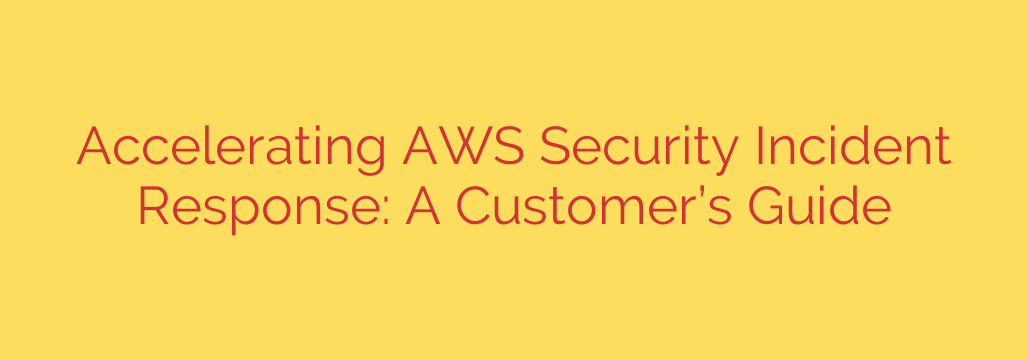
Fortify Your Cloud: A Proactive Guide to Faster AWS Security Incident Response
In the dynamic world of cloud computing, a security incident isn’t a matter of if, but when. When an alert fires or suspicious activity is detected in your AWS environment, every second counts. A slow, disorganized response can lead to wider breaches, significant data loss, and costly downtime. The key to mitigating damage is not just reacting, but having a well-orchestrated, proactive plan in place.
A robust incident response strategy transforms a potential crisis into a manageable event. It empowers your team to act decisively, minimize the blast radius of an attack, and restore normal operations swiftly and securely. This guide outlines the essential pillars for building an effective AWS security incident response plan.
The Critical Need for a Proactive Plan
Reacting to a security event in the heat of the moment without a plan is a recipe for failure. Teams scramble to find the right permissions, locate critical logs, and decide on a course of action, all while an attacker may still be active in the environment.
A proactive approach ensures that the necessary tools, permissions, and processes are established before an incident occurs. This preparation is the single most important factor in accelerating your response time and ensuring a successful outcome.
Phase 1: Foundational Preparation – Your First Line of Defense
Effective incident response begins long before an alert is triggered. Setting up your AWS environment correctly is non-negotiable.
Establish a Dedicated Security Account: Isolate your security tooling and incident response personnel within a separate AWS account. This centralization helps protect your security tools from being compromised during an event and provides a single pane of glass for monitoring and response activities.
Create Pre-Approved IAM Roles for Incident Response: During a crisis, you cannot afford to waste time requesting access. Create dedicated IAM roles for your security team with the specific permissions needed to investigate and contain threats. This “break-glass” access should grant permissions for tasks like describing resources, analyzing logs, and taking forensic snapshots of EC2 instances. Crucially, these roles should follow the principle of least privilege, providing just enough access to be effective.
Enable and Centralize Comprehensive Logging: You can’t analyze what you don’t log. Ensure that critical logging services are active and their data is being securely stored, preferably in a centralized S3 bucket within your security account. Key services to enable include:
- AWS CloudTrail: Provides a detailed audit trail of every API call made in your account.
- VPC Flow Logs: Captures information about the IP traffic going to and from network interfaces in your VPC.
- DNS Logs: Records DNS queries made by resources within your VPC.
Phase 2: Swift Detection and Analysis
With a solid foundation, your next step is to ensure you can detect malicious activity quickly and accurately. AWS provides powerful native tools to help.
Leverage Threat Detection Services: Amazon GuardDuty acts as an intelligent threat detection service that continuously monitors for malicious activity and unauthorized behavior. It analyzes multiple data sources, including CloudTrail, VPC Flow, and DNS logs, using machine learning and threat intelligence to identify potential threats.
Aggregate Findings with AWS Security Hub: Security Hub gives you a comprehensive view of your high-priority security alerts and compliance status across your AWS accounts. It aggregates findings from services like GuardDuty, Amazon Inspector, and Amazon Macie, reducing alert fatigue and helping you prioritize your response efforts.
Automate Initial Triage: For common or low-level alerts, consider using services like AWS Lambda to automate the initial investigation. An automated function can enrich an alert with contextual data, such as the owner of an EC2 instance or the permissions of an IAM user, allowing your security analysts to focus on higher-priority threats.
Phase 3: Decisive Containment and Evidence Preservation
Once a threat has been identified and validated, you must act quickly to contain it and preserve evidence for forensic analysis.
Isolate the Affected Resource: Immediately remove the compromised resource from the network to prevent lateral movement. This can be done by modifying its security group to deny all traffic or by moving it to an isolated “quarantine” VPC.
Preserve Evidence for Forensic Analysis: Before terminating a compromised resource, you must preserve its state for investigation. Immediately take a snapshot of the affected instance’s EBS volume. This snapshot can later be attached to a new, isolated “forensic” EC2 instance for deep-dive analysis without risking further contamination.
Revoke and Rotate Compromised Credentials: If you suspect that IAM user credentials, roles, or access keys have been compromised, they must be revoked immediately. Invalidate active sessions and rotate all keys associated with the affected resource or user to lock out the attacker.
Phase 4: Recovery and Continuous Improvement
After containing the threat and analyzing the evidence, the final steps are to recover and learn from the incident.
Eradicate and Recover: Rebuild the compromised system from a known-good backup or a golden AMI (Amazon Machine Image). Ensure that the vulnerability that allowed the initial compromise has been patched or mitigated before bringing the new resource online.
Conduct a Post-Incident Review: This is one of the most valuable parts of the process. Hold a blameless post-mortem to analyze the root cause of the incident. Ask critical questions: How did the attacker get in? Why weren’t our defenses effective? What could we have done better?
Update Your Playbooks: Use the findings from your review to strengthen your security posture and update your incident response playbooks. This creates a feedback loop of continuous improvement, ensuring you are better prepared for the next event.
By embracing a proactive mindset and implementing these structured strategies, you transform incident response from a chaotic scramble into a well-orchestrated process. A prepared team is an effective team, capable of protecting your AWS environment, your data, and your organization’s reputation.
Source: https://aws.amazon.com/blogs/security/aws-security-incident-response-the-customers-journey-to-accelerating-the-incident-response-lifecycle/








